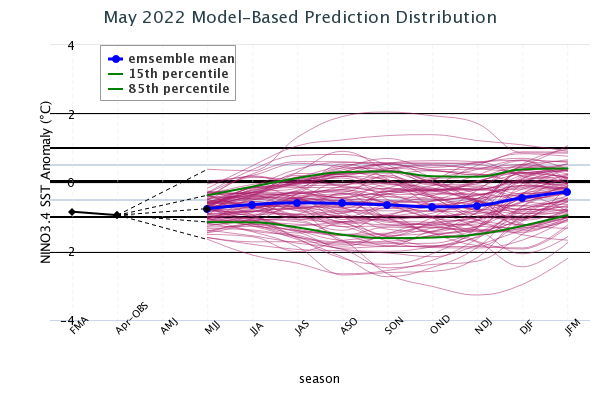IRI ENSO Forecast
IRI Technical ENSO Update
Published: May 19, 2022
Note: The SST anomalies cited below refer to the OISSTv2 SST data set, and not ERSSTv5. OISSTv2 is often used for real-time analysis and model initialization, while ERSSTv5 is used for retrospective official ENSO diagnosis because it is more homogeneous over time, allowing for more accurate comparisons among ENSO events that are years apart. These two products may differ, particularly during ENSO events. The difference between the two datasets may be as much as 0.5 C. Additionally in some years, the ERSSTv5 may tend to be cooler than OISSTv2 in the context of warming trends, because ERSSTv5 is expressed relative to a base period that is updated every 5 years, while the base period of OISSTv2 is updated every 10 years. In February 2021, both datasets were updated to reflect the 1991-2020 climatology period.
Recent and Current Conditions
The SST anomaly for NINO3.4 during the Feb-Apr season was -0.85 C, and for the month of April it was -0.95 C. The most recent weekly (11 May 2022) anomaly in the NINO3.4 region was -1.1 C, indicating a continuation of the current La Niña event. The IRI’s definition of El Niño, like NOAA/Climate Prediction Center’s, requires that the SST anomaly in the NINO3.4 region (5S-5N; 170W-120W) exceed 0.5 C. Similarly, for La Niña, the anomaly must be -0.5 C or less.
Many of the key atmospheric variables remain indicative of La Niña conditions. The traditional and equatorial Southern Oscillation Indices are positive and intensified further during April 2022, and continued to be so through mid-May 2022. The low-level wind anomalies are near normal and upper-level wind anomalies remain westerly across the tropical Pacific; anomalously dry conditions have been observed around the date line. Across most of the equatorial Pacific Ocean, temperatures are below average near the surface, extending down to 100 meters on the eastern side. However, subsurface temperatures in the western and central Pacific are warmer than average, mainly at depths of 100-200 meters.
In summary, tropical Pacific atmospheric and oceanic conditions are consistent with La Niña. A La Niña advisory is still in place.
Expected Conditions
Note – Only models that produce a new ENSO prediction every month are considered in this statement.
What is the outlook for the ENSO status going forward? El Niño/Southern Oscillation (ENSO) Diagnostic Discussionissued jointly on 12 May 2022 by the Climate Prediction Center/NCEP/NWS and the International Research Institute for Climate and Society indicates a continuation of the current La Niña event during the Northern Hemisphere summer.
The latest set of model ENSO predictions from mid-May is now available in the IRI/CPC ENSO prediction plume. These are used to assess the probabilities of the three possible ENSO conditions by using the average value of the NINO3.4 SST anomaly predictions from all models in the plume, equally weighted. A standard Gaussian error is imposed over that average forecast, and its width is determined by an estimate of overall expected model skill for the season of the year and the lead time. Higher skill results in a relatively narrower error distribution, while low skill results in an error distribution with width approaching that of the historical observed distribution. Using this method, the chances of La Niña are 62% for the Jun-Aug season, while those of the ENSO-neutral category are 37%. The probability of La Niña for the subsequent seasons is forecasted to be between 55-60%, decreasing to 47% in Dec-Feb and 37% in Jan-Mar. ENSO-neutral is the second most likely category throughout the forecast period, while El Niño likelihoods remain very low. A plot of the probabilities summarizes the forecast evolution. The climatological probabilities for La Niña, ENSO-neutral, and El Niño conditions vary seasonally, and are shown in a table at the bottom of this page for each 3-month season.
Caution is advised in interpreting the forecast distribution from the Gaussian standard error as the actual probabilities, due to differing biases and performance of the different models. In particular, this approach considers only the mean of the predictions, and not the total range across the models, nor the ensemble range within individual models. At longer leads, the skill of the models degrades, and uncertainty in skill must be convolved with the uncertainties from initial conditions and differing model physics, which leads to more climatological probabilities in the long-lead ENSO Outlook than might be suggested by the suite of models. Furthermore, the expected skill of one model versus another has not been established using uniform validation procedures, which may cause a difference in the true probability distribution.
In summary, the probabilities derived from the models in the IRI/CPC plume indicate a preference for the continuation of the La Niña during the forecast period with moderate probability. The likelihood for El Niño development remains very low.
A caution regarding the model-based ENSO plume predictions released mid-month, is that factors such as known specific model biases and recent changes in the tropical Pacific that the models may have missed, are not considered. This approach is purely objective. Those issues are taken into account in the official outlooks, which are generated and issued early in the month by CPC and IRI, and which will include some human judgment in combination with the model guidance.

| Season |
La Niña |
Neutral |
El Niño |
| MJJ |
81 |
19 |
0 |
| JJA |
62 |
37 |
1 |
| JAS |
56 |
41 |
3 |
| ASO |
57 |
39 |
4 |
| SON |
58 |
36 |
6 |
| OND |
60 |
33 |
7 |
| NDJ |
58 |
34 |
8 |
| DJF |
47 |
42 |
11 |
| JFM |
37 |
50 |
13 |





